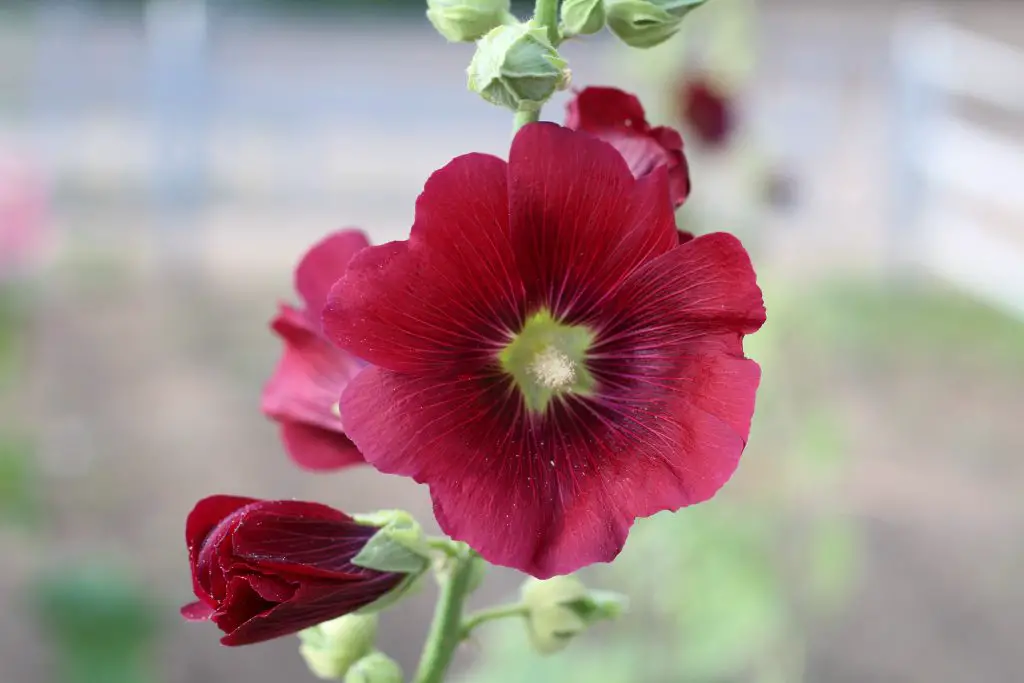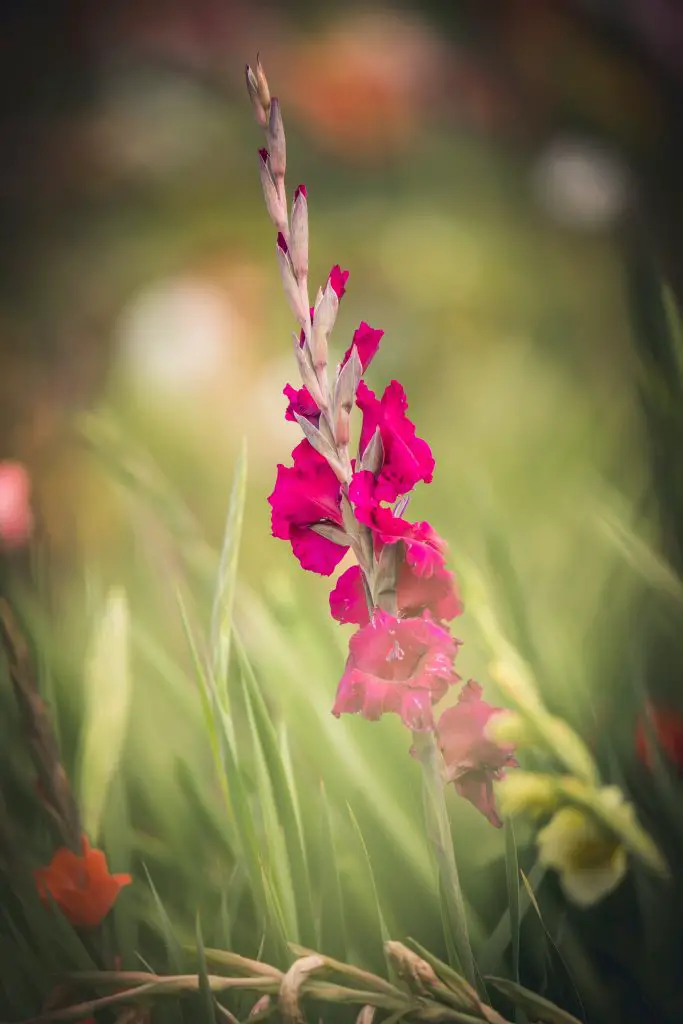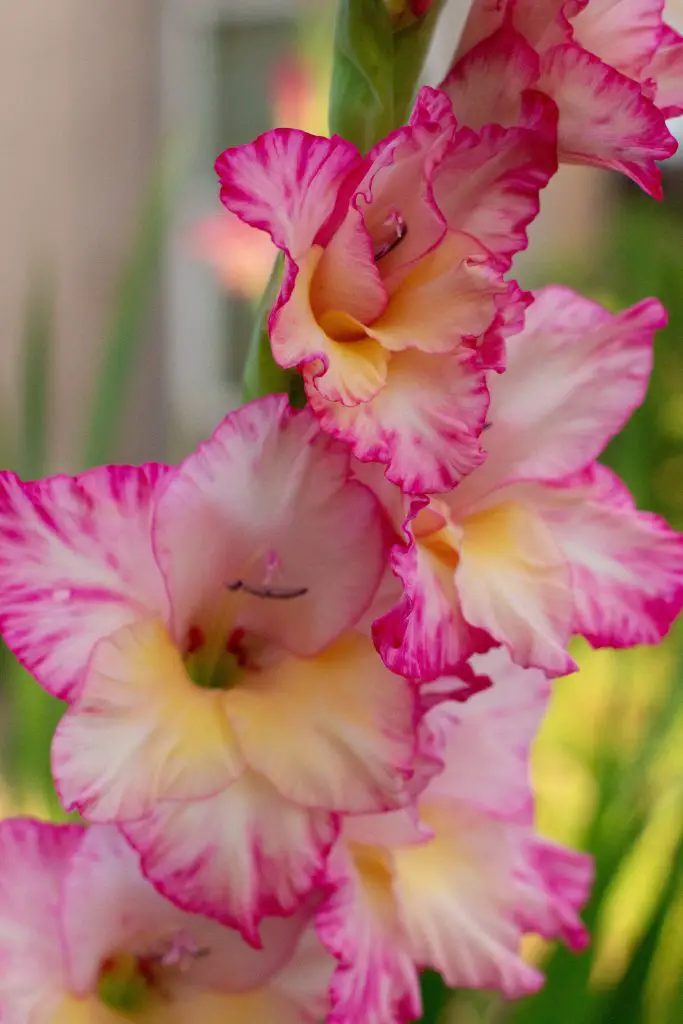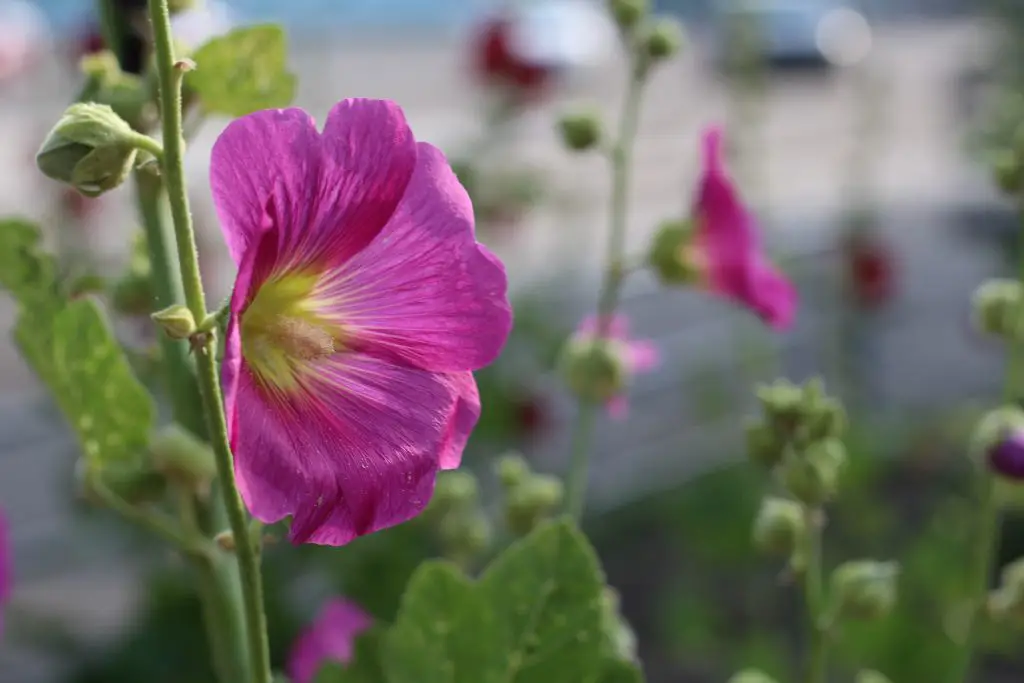What’s The Difference Between Gladiolus And Hollyhocks? Hollyhocks and gladiolus are some of the more popular flowers that are grown in the garden. Both plants produce relatively tall spires that add beauty and interest to any ornamental garden, however, if you are new to gardening you may be wondering what the difference is between a gladiolus and a hollyhock.
The primary difference between gladiolus and hollyhocks is the way that they grown. Gladiolus are considered to be a summer flowering bulb because they have a corm that can be planted in spring to produce a summer display whereas hollyhocks are grown from seed and are available in perennial biannual and annual varieties which also generally flower and summer.
In addition to this gladiolus and hollyhocks have distinctly different shaped flowers that are easy to tell apart. Gladiolus has tubar-shaped flowers with a ruffled outer edge that generally points upward whereas hollyhocks have an open faced flower that typically sits upright on the side of the flower stalk in a similar manner to a badge being pinned to someone’s chest.
Both flowers also come in a wide range of colours which includes reds, pinks, whites, and yellow though hollyhocks also feature varieties that have black flowers which is quite a striking flower.

However, the one key advantage that hollyhocks have over gladiolus is it they are not considered to be toxic though they will still cause some skin irritation in sensitive people. This is a major advantage that hollyhocks have over most of the other plants that produce tall flowers spikes such as gladiolus, foxgloves or delphiniums which are all considered to be extremely toxic.
About Gladiolus
Gladiolus are a member of the iris family and produce striking flowers which are sometimes referred to as sword lilies. These plants are native to Africa and Europe and the Mediterranean with there being over 300 different species within the genus. Gladiolus typically produce a sword-like stem that is usually between 2 and 6 ft tall with a trumpet-shaped flower.
These trumpet-shaped flowers often have frilled or ruffled petals in a range of colours as mentioned above. The plants themselves are suitable for growing in zones 5 to 11 though you do need to carefully select the right variety that you grow as there are some varieties that are only hardy down to Zone 8.
However, as these plants are produced from corms and can be treated as annuals by digging up the corms and storing them indoors before the first frost which will avoid the worst of the winter weather.
However, if the climate that you live in is warm enough you will be able to leave the plants in the ground and gladiolus will grow back year after year slowly spreading and multiplying if the conditions are favourable. The other advantage they have is that they are resistant to animals such as deer and rabbits due to their toxicity.

There are four major groups that these plants can be divided into. The first type is a spring blooming gladioli, Byzantine Gladiolus. This group of gladiolus are the earliest flowering varieties and they typically reach 2 to 3 ft tall and are hardy in zones 6 to 10.
The second type is Grandiflora Hybrids gladiolus. This group is generally considered to be the most important group of gladiolus because there is such a wide range of cultivars available to choose from.
These plants generally produce flower spikes that are larger than the spring blooming varieties and typically reach between 3 and 6 ft tall though there are also dwarf varieties available in this group. One advantage of the smaller gladiolus is they don’t require any staking or support to keep the flower stalks upright.
This group of plants is most suited to growing in zones 8 to 11 and typically will flower from mid-summer to early fall in most cases.
The third group is Nanus hybrids, which are also sometimes referred to as butterfly gladioli. They produce flowers that are generally smaller than the Grandiflora hybrids. These varieties are generally considered to be less formal in appearance than other gladiolus varieties and they bloom typically in early to late summer.

Most varieties in this group can be grown from zones 5 to 10 though in zone 5 you will need to add a little bit of extra protection to ensure that the corms survive in the cold weather.
The fourth variety is commonly referred to as Abyssinian Sword Lily. This group of plants is native to Africa and differs from other gladiolus plants because they have relatively open flowers compared to other varieties. These plants are relatively small compared to other gladiolas only reaching a height of approximately 2 to 3 ft tall. They produce flowers in late summer and early fall and are hardy in zones 7 to 10.
Given that there is such a wide variety of gladioli it may be difficult to identify the varieties that suit your particular garden. To aid in the selection of the plant would highly recommend that you visit gardenia.net as they have a highly interactive website that allows you to see a huge range of gladiolus varieties that are available.
About Hollyhocks
Hollyhocks are a part of the Alcea genus which has over 50 different species within it that are native to either Europe or Asia. Hollyhocks can be annual, biennial, or perennial however the most common varieties are typically biennial forms.
Most species within this genus produce relatively tall flower spikes that range in height from 4 to 8ft depending upon the specific variety. These plants are relatively hardy and suitable for growing in zones 3 to 9 with most varieties producing flowers in mid to late summer.
These plants come in a wide range of colors which include red, pinks, purples, white, and pale yellow plants along with a striking black variety which is particularly well known called Black Knight. To see a variety of these species try visiting gardenia.net as it has a terrific database covering a wide range of varieties.
The plants are often used to provide height and structure to borders and generally prefer to be grown in a full sun location that has rich, moist, and free-draining soils though the plants are known to tolerate a wide range of soil conditions. The only type of soil that is particularly challenging for hollyhocks is boggy soil which it will not tolerate.

The plants are attractive to a wide range of wildlife and are resistant to pests such as rabbits. The plants will readily self-seed, however, there are some species within the US that have been classed as being invasive.
To propagate the plants most gardeners start the seeds off in mid-winter indoors in relatively warm conditions which ensures that you get a relatively early flowering. The plants are then generally cut back after flowering and the dried stems, in some cases, are actually used as kindling in firewood because they dry up very nicely making them quite useful plants.
I hope you found this article useful and have great success growing either hollyhocks or gladiolus in your garden at home, if you have any additional comments or questions please leave them in the section below.
Relevant Articles
Are Hollyhocks Poisonous? Can I touch Them?
What’s The Difference Between Foxgloves And Hollyhocks?
Do Gladiolus Spread? Are They Invasive?
Is It Too Late To Plant Gladiolus Bulbs?
